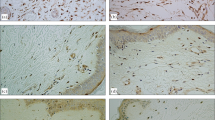Abstract
The goal of the work is to study the content of the mechanosensitive protein Piezo1 in fibroblasts and blood vessels of the human dermis from embryonic development to very old age (from 20 weeks of pregnancy to 85 years) and to define the value of Piezo1 for age-related changes in the number of fibroblasts and blood vessels in the human dermis. Piezo1, proliferating cell nuclear antigen (PCNA), and CD31, a marker of endothelial cells, were detected in skin sections by an indirect immunohistochemical technique. The results showed that the proportion of fibroblasts with positive staining for Piezo1 in human dermis decreases systematically from 20 weeks of pregnancy to 40 years old. From the age of 41, there is a sharp increase in the proportion of dermal fibroblasts with positive staining for Piezo1, with the maximum in the age group of 61–85 years. The Piezo1 content in the blood vessels of the human dermis decreases from 20 weeks of pregnancy to 40 years. A significant increase in the Piezo1 content in the blood vessels of the human dermis is then observed in the age group of 41–85 years. The age-related changes in the Piezo1 content in fibroblasts and blood vessels of the dermis are not associated with the age-related decrease in the total number and proportion of PCNA-positive fibroblasts or the number of blood vessels in the dermis.




Similar content being viewed by others
REFERENCES
Gunin, A.G. and Golubtsova, N.N., Thyroid hormone receptors in human skin during aging, Adv. Gerontol., 2018, vol. 8, no. 3, pp. 216–223.
Gunin, A.G., Petrov, V.V., Vasilieva, O.V., and Golubtsova, N.N., Age-related changes of blood vessels in the human dermis, Adv. Gerontol., 2015, vol. 5, no. 2, pp. 65–71.
Albarran-Juarez, J., Iring, A., Wang, S., et al., Piezo1 and Gq/G11 promote endothelial inflammation depending on flow pattern and integrin activation, J. Exp. Med., 2018. pii jem.20180483.
Borbiro, I. and Rohacs, T., Regulation of Piezo channels by cellular signaling pathways, Curr. Top. Membr., 2017, vol. 79, pp. 245–261.
Cox, C.D., Bavi, N., and Martinac, B., Origin of the force: the force-from-lipids principle applied to Piezo channels, Curr. Top. Membr., 2017, vol. 79, pp. 59–96.
Fritz, P., Hones, J., Lutz, D., et al., Quantitative immunohistochemistry: standardization and possible application in research and surgical pathology, Acta Histochem., 1989, vol. 37, suppl., pp. 213–219.
Gudipaty, S.A., Lindblom, J., Loftus, P.D., et al., Mechanical stretch triggers rapid epithelial cell division through Piezo1, Nature, 2017, vol. 543, no. 7643, pp. 118–121.
Gunin, A.G., Kornilova, N.K., Vasilieva, O.V., and Petrov, V.V., Age-related changes in proliferation, the numbers of mast cells, eosinophils, CD45 positive cells in human dermis, J. Gerontol. A, 2011, vol. 66, pp. 385–392.
Gunin, A.G., Petrov, V.V., Golubtzova, N.N., et al., Age-related changes in angiogenesis in human dermis, Exp. Gerontol., 2014, vol. 55, pp. 143–151.
Li, X.F., Zhang, Z., Chen, Z.K., et al., Piezo1 protein induces the apoptosis of human osteoarthritis-derived chondrocytes by activating caspase-12, the signaling marker of ER stress, Int. J. Mol. Med., 2017, vol. 40, no. 3, pp. 845–853.
Martinac, B. and Poole, K., Mechanically activated ion channels, Int. J. Biochem. Cell. Biol., 2018, vol. 97, pp. 104–107.
Parpaite, T. and Coste, B., Piezo channels, Curr. Biol., 2017, vol. 27, pp. R250–R252.
Qin, Z., Xia, W., Fisher, G.J., et al., YAP/TAZ regulates TGF-β/Smad3 signaling by induction of Smad7 via AP-1 in human skin dermal fibroblasts, Cell. Commun. Signaling, 2018, vol. 16, p. 18.
Rizzardi, A.E., Johnson, A.T., Vogel, R.I., et al., Quantitative comparison of immunohistochemical staining measured by digital image analysis versus pathologist visual scoring, Diagn. Pathol., 2012, vol. 7, p. 42.
Romac, J.M., Shahid, R.A., Swain, S.M., et al., Piezo1 is a mechanically activated ion channel and mediates pressure induced pancreatitis, Nat. Commun., 2018, vol. 9, no. 1, p. 1715.
Saotome, K., Murthy, S.E., Kefauver, J.M., et al., Structure of the mechanically activated ion channel Piezo1, Nature, 2018, vol. 554, no. 7693, pp. 481–486.
Seidal, T., Balaton, A.J., and Battifora, H., Interpretation and quantification of immunostains, Am. J. Surg. Pathol., 2001, vol. 25, pp. 1204–1207.
Wang, A.S. and Dreesen, O., Biomarkers of cellular senescence and skin aging, Front. Genet., 2018, vol. 9, p. 247.
Wei, W. and Ji, S., Cellular senescence: molecular mechanisms and pathogenicity, J. Cell. Physiol., 2018. https://doi.org/10.1002/jcp.26956
Zhao, Q., Zhou, H., Chi, S., et al., Structure and mechanogating mechanism of the Piezo1 channel, Nature, 2018, vol. 554, no. 7693, pp. 487–492.
Funding
This work was supported by the Russian Foundation for Basic Research, project nos. 18-44-210001 and 19-415-210001, and the government of the Chuvash Republic.
Author information
Authors and Affiliations
Corresponding author
Ethics declarations
Conflict of interests. The authors declare that they have no conflict of interest.
Statement of compliance with standards of research involving humans as subjects. The study was approved by the ethics committee of the medical faculty of Chuvash State University.
Additional information
Translated by I. Shipounova
Rights and permissions
About this article
Cite this article
Gunin, A.G., Golubtzova, N.N. Role of the Mechanosensitive Protein Piezo1 in Age-Dependent Changes in the Number of Fibroblasts and Blood Vessels in Human Skin. Adv Gerontol 9, 411–416 (2019). https://doi.org/10.1134/S2079057019040088
Received:
Revised:
Accepted:
Published:
Issue Date:
DOI: https://doi.org/10.1134/S2079057019040088




